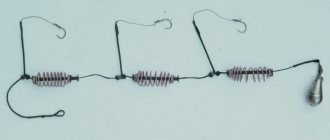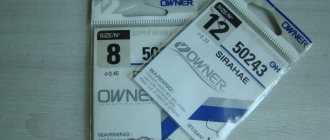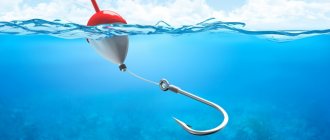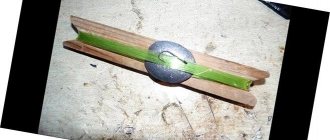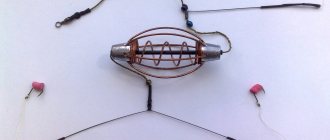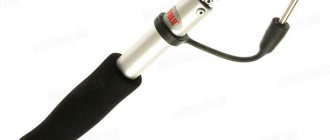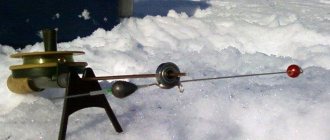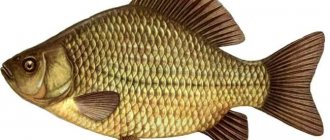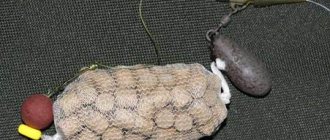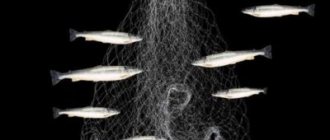Catching crucian carp on a donk with a spring feeder
Fishing for crucian carp using a spring-type feeder is often much more effective than a pickerel with a light sinker, when the bait is delivered to the fishing point by hand casting or using a special slingshot or sling. When casting a short distance from the shore, the picker undoubtedly wins due to the elegance and lightness of the tackle. But for long casts it is better to use a feeder rod and equipment with a spring feeder.
Bottom tackle for catching crucian carp is attached to the main feeder line, for which in the summer it is better to use a monofilament feeder line with a diameter of 0.18-0.2 mm. The bottom rig for crucian carp is a spring feeder with short leashes that are tied above and below the feeder. On leashes made of fluorocarbon with a thickness of 0.16-0.14 mm, you can tie carp hooks No. 4-5 of Russian numbering. The length of the leashes can be 7-10 cm. Longer leashes will twist and get tangled, especially since we are supposed to put foam balls on the hooks in our equipment. For what? The fact is that when fishing for crucian carp on a muddy bottom, hooks with bait are often not visible to the fish among the soft silt and vegetation. That is, there is no moment of visual detection of bait by crucian carp, and it can only find the bait by smell or by chance. This reduces the number of bites. The foam lifts the bait off the bottom. In addition, there are those who like to fish with “naked” foam, smeared with bait, aromatics, and sprayed with “worm” and “maggot” dips. Crucians often grab foam balls located next to the feeder even without dip treatment.
Catching crucian carp in summer on a feeder using a bottom rig of the “yoke” type is more effective than using a feeder and leashes tied nearby. Why? Short leashes with hooks never overlap with the main line and with each other, which happens with the first version of a simpler bottom rig. The “yoke” can be purchased ready-made at the store or made from spring wire yourself. The length of its arm is usually about 6-7 cm, which will make the total length of the rocker arm 12-14 cm. And, I think, there is no need to equip your feeder donka with many hooks in the form of the above-mentioned donka called “crucian carp killer”. There will be confusion and unnecessary fuss with hooks. Two hooks are enough if the crucian carp is active and bites well.
Using bait for crucian carp
In the summer, fishermen often use animal baits, for example, bloodworm larvae, as feeding. To fill the feeder, it seems appropriate to boil a glass of millet, and after preparing it, add the crucian carp’s favorite delicacy - sweet corn grains and cake. All this must be thoroughly mixed with the addition of water, possibly taken from the reservoir or lake where this crucian carp lives. You can use garlic, honey or caramel as a flavoring.
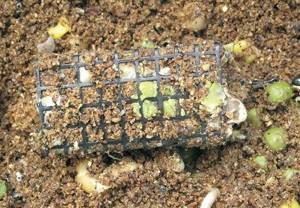
When using the feeder directly, it is possible to use open and closed feeders. In the first case, the food is gradually washed away by the current. As a rule, in the second case, a special mini-container with several small holes is used, which can be filled with both bait of plant and animal origin. Basically, the use of a closed model occurs in stagnant bodies of water, where there is no current as such.
On a donk with a float
Fishing for crucian carp in summer is also possible in the form of a symbiosis of float gear with bottom gear. This is for float lovers, who are often so passionate about fishing with a fishing rod that they simply cannot imagine fishing for crucian carp without a float. The donk fishing method with a float combines the use of a match sliding float and a light spring feeder. Here everything is the same as with bottom fishing, only a silicone stopper is installed on the fishing line, against which the sliding float rests when floating to the surface of the pond. And the stopper is fixed at a distance from the hook, which corresponds to the depth at the fishing point.
Float fishing rod with feeder: how to make
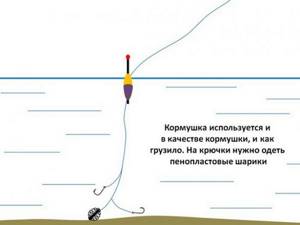
To build such a tackle, you will need the following individual elements:
- Sliding float, with 20-30 grams of dough.
- Sliding feeder, same mass.
- A fishing line (piece) about 30 centimeters long.
- A pair of hooks.
- Material for making leashes.
- Knitting wire.
A sliding float and a feeder can be easily purchased at a fishing store, after which they are attached to a fishing rod at home. The store sells floats with a carrying capacity of more than 20 grams.
In order not to waste money, it is permissible to make this type of float yourself using a foam ball and a plastic tube.
The procedure is as follows:
- To begin with, you should take a plastic tube (you can use a gel pen), 3 mm in diameter and about 20 cm long. The tube can be coated with bright waterproof varnish.
- Inside a foam ball, up to 5 cm in diameter, a through hole is made with a sharp object.
- Part of the tube is coated with waterproof glue and tightly inserted into the hole in the ball.
- Take a sliding feeder with a load inside.
- The fishing line with the feeder is attached to the clasp.
- A rubber stopper is installed on the main line.
- The clasp is attached to the installed stopper.
On a note! To glue a plastic tube to a foam ball, it is better to use Dismakol shoe glue.
Using a float rod with a feeder, it is permissible to fish from any distance, as well as from a boat. The feeder slides without any problems along a piece of fishing line about 20 cm long and 0.25 mm thick. A loop is formed at one end of the piece of fishing line, and a fastener of the type shown in the image below is attached to the other end.
It is better to choose reliable fasteners so that the gear does not fail at the most inopportune moment.
Then they begin to manufacture the rocker arm.
The rocker can be bought in a store, but the simplicity of the design allows you to make it at home. It is enough to take a rigid wire, a couple of millimeters thick and about 12 cm long. In the center of the piece of wire you need to form a ring for fastening. The same rings are formed at the ends of the rocker for attaching leashes with hooks.
As a result of the next steps, you should get what is visible in the image below.

Note to anglers! You can get by with one leash, up to 15 cm long and with one hook.
It is very important not to ignore the installation of stoppers on the fishing line, since they perform a very important function. The stoppers are presented in the form of small cylinders. They do not slip during fishing. The image below shows stoppers with clasps.
The functions of the stoppers are to soften the impacts of the equipment elements during casting. Because the fasteners are uniquely designed, the sliding floats are easy to thread through. As practice shows, this is the most optimal equipment option.
After all the main elements are mounted on the fishing rod, a loop is formed at the end for attaching a rocker with hooks or a leash with one hook. In the image below you can see what the assembled fishing rod with feeder looks like.
The image shows that the main line passes through the float. If you secure the float with a clasp, you get a more versatile tackle. If you use only one hook, without a rocker, you can get a more sensitive equipment.
To increase the likelihood of a bite, it is better to equip the fishing rod with a leash with a hook no longer than 5-7 cm. Since the baited hook is located next to the feeder, the chances of catching any fish increase.
Note to anglers! Such gear requires the use of a rod with a weight of at least 35 grams. It is better to use a feeder rod, as it is designed for this type of equipment. The size of the hooks is selected depending on the size of the expected catch.
The image below shows a type of feeder without a weight, called a “spring”.
This type of feeder is used in conjunction with sliding weights weighing from 15 to 20 grams. In this way, it is possible to obtain a montage that is more sensitive. With the help of such a fishing rod it is permissible to fish at a distance of up to 30 meters. Naturally, in this case you will need a spinning reel of size 2000-3000. Such gear allows you to fish any promising points on the reservoir.
Improved version of the “crucian carp killer”
Many anglers complain that this tackle is not very sensitive. Therefore, sometimes it is not possible to see a bite and react to it. Another nuance is related to the fact that cautious crucian carp often refuses to bite - it feels the resistance of the feeder. As a result, having tried the bait, the fish simply abandons it.
However, all shortcomings are easily corrected. A slightly modified installation will help with this, in which the leashes cling not to the feeder, but to movable swivels. Let's start in order:
- You will also need monofilament or fluorocarbon fishing line, braid or nylon cord 60-100 cm long.
- A swivel with a fastener for a sinker is tied to one end.
- Approximately 10 cm is removed from it and a stop bead is fixed. For example, you can pass the fishing line through it twice and tie it with a double knot. We put a swivel and another bead.
- Then it’s time to install the sliding feeder. We put it on the fishing line so that it rests against the stopper. We retreat 5-7 cm and fix the next two locking beads, between which we do not forget to place a swivel. After which another feeder and again a stopper.
- You can leave two feeders. But it’s best to fish with a “garland” of three. Therefore, we install another feeder using the same method.
- We retreat 10 cm from it and cut off the remaining part of the fishing line or cord. We install a larger swivel with a clasp for quick attachment to any gear.
- We tie leashes to the free eye of each intermediate swivel. They can be left longer than 4-7 cm. However, for this you need to put plastic or rubber tubes on the leashes, which will work as an anti-twist line.
What is the advantage of this equipment option? Firstly, when starting to swallow the bait, the crucian carp does not feel the resistance and weight of all the feeders. When biting, he pulls in a free supply of fishing line. However, with a strong jerk, the fish easily hooks itself, because the same supply of thread rests against the feeder with a stopper.
Advantages and disadvantages of a fishing rod with a feeder for crucian carp
Most often, fishermen use float rods with a feeder if they plan to cast gear over long distances from the shore. This is a good way to ensure that the bait is delivered exactly to the fishing spot. But even if you fish in the coastal zone with a regular fly rod, placing the feeder in close proximity to the equipment can give good results. Like any fishing tackle, a fishing rod with a feeder has its advantages and disadvantages, which should be taken into account before making it or buying a ready-made version.
- In particular, the advantages of fishing with this tackle include the following:
- the ability to deliver bait not only to the bottom, but also to the middle water layers of the reservoir;
- good placement of bait increases the number of bites, which means it gives more chances for a good catch;
- the ability to fish any horizon;
- absolute precision of bait delivery;
- the device can be easily made and improved in the future;
- works well in bad weather when fish prefer to go deeper;
- The tackle is suitable for catching various types of fish.
In addition to all the advantages, one should not forget about the disadvantages of such a hybrid of bottom and float fishing rods. There is, perhaps, only one here and not so significant: from time to time the leashes and the feeder can get tangled, especially if the distance between them is small.
Important! The rig will be more sensitive to bites if the float is so submerged in the water that only the antenna is visible.
Lures and baits for crucian carp
First of all, it is worth noting that crucian carp is a rather finicky fish, so you should approach its fishing with the utmost care. This especially applies to the choice of nozzle.
Most fishermen believe that crucian carp are easiest to catch using earthen bait:
- Dung worms;
- Maggots;
- Bloodworm and so on.
Among them, one of the most notable are dung worms, since they behave very actively and mobilely on the hook. It should also be said that another advantage is the presence of a specific smell that crucian carp really like.
Bloodworms or maggots can be used in reservoirs where, apart from crucian carp, there are no other fish. If you use these baits on reservoirs containing other species, you can be absolutely sure that the fishing will not be effective, and besides, the bait will have to be constantly changed.
This is due to the fact that various small fish actively absorb such bait, leaving the crucian carp not the slightest chance to bite.
When catching large individuals, it is best to use the so-called sandwich, which includes crawlers. This bait will not allow small fish to swallow itself.
Not long ago, experienced fishermen began to use new baits when catching crucian carp, among which the most profitable are:
- Frozen French fries;
- Frozen shrimp meat.
Fish are not always consistently caught using French fries - it depends on the weather and its mood, but shrimp meat will be an excellent bait in the hot season. It should also be said that this bait will hold perfectly on the hook.
Semolina chatter is also a good bait for catching crucian carp. Each angler prepares this bait in his own way, but there is a universal recipe for preparation. It is worth noting that most experienced fishermen consider semolina chatter to be the most attractive bait.
In order to prepare mash, take one and a half teaspoons of semolina and pour them into an enamel container, which, if possible, should be painted white. This is very important, since in hot weather such dishes can keep the mash for quite a long time.
Now pour one teaspoon of water into the semolina and mix thoroughly until you get a dough-like consistency.
Subsequently, the dishes are closed and placed in a warm place. If the bait turns out to be too cool, then dilute it a little with water and stir. It is worth noting that semolina chatter can be used both individually and in combination with other types of bait.
Crucian carp is also perfectly caught using bait made from yeast or ordinary dough. Moreover, in this case, you should not limit yourself to ordinary flour, but use cereals made from corn, peas, wheat, and so on. The dough itself is not too difficult to make, so even novice fishermen can do it.
The cooking recipe here is as follows: the cereal is ground to flour and diluted with water so that the mass does not stick to your hands.
Experienced fishermen add certain flavorings to the dough, among which the most effective are:
- Garlic;
- Dill;
- Honey and others.
By adding them, the fisherman increases his chances of catching large crucian carp.
Effective baits
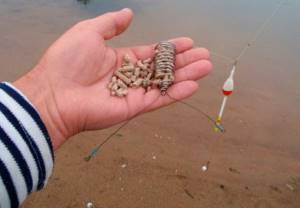
If you go fishing with the goal of catching fish, but without bait, then it makes no sense to count on a serious catch. Therefore, first of all, you need to decide on bait. At the same time, its consistency should be such that it is washed out of the feeder within 5 minutes. The nature of the bait must meet certain requirements: if it is easy to press, then it should fall apart, but not stick together into one solid lump when it gets into the water. The basis of the bait is: small cake (makuha), breadcrumbs, boiled millet.
To catch roach and crucian carp, we can recommend an effective bait recipe:
- Up to 300 g of fresh, small cake.
- Up to 500 g breadcrumbs.
- Up to 200 g crushed biscuits.
- Up to 300 g of boiled millet.
- Anise flavor.
What is the advantage of bait? When it gets into the water, it creates a feeding spot, washing out of the feeder in 5 minutes. After several casts, a cloud of dust appears in the water, which attracts many fish. Adding coconut shavings allows you to create a stable feeding spot in the water, which attracts a large school of fish.
Instead of poppy seeds, you can use toasted seeds, which should be crushed in a coffee grinder: the effect will be even better. As a basis, you can take ready-made factory bait for fishing on a feeder for crucian carp, bream or roach. As a rule, this is fine-grained bait, which should include a biscuit and breadcrumbs. If desired, boiled peas or millet are added to this bait.
It is not necessary to boil the millet, but simply pour boiling water over it and leave it there for at least 6 hours. Peas should be cooked for at least half an hour until fully cooked. These components are added to the bait depending on the nature of the fish’s bite.
Using a feeder with bait always gives a positive result, especially in cases where the angler casts the tackle at the same point. Therefore, the bait with the hook always ends up in the fish’s activity zone.
The consistency of the bait should be such that the fishing conditions are taken into account. When fishing in still water, the bait should be loose, “Geyser” type, which, when it gets into the water, begins to open up.
If fishing is carried out in conditions of a current, then the bait should be denser, but in any case, it should be washed out of the feeder within 5 minutes. The density of the bait can be adjusted by adding water or dry ingredients. An experienced fisherman always knows what bait should be when fishing on a river or lake.
Bait and attachments for crucian carp killer tackle
The success of catching crucian carp with killer bait largely depends on properly prepared bait and its consistency. After casting, the bait should not fall apart into small pieces and spill out from the feeder. To do this, its consistency must be sufficiently viscous and thick . For this, various boiled porridges with flavorings , to which oatmeal .
Some fishermen mix the bait so thick that its consistency becomes closer to plasticine or resembles a very thick dough . Ultimately, the spring with bait is more like a pacifier - the inability to reach the bait, which is very close, only activates the crucian carp to bite on the bait with a hook.
As bait, you can use the entire range of baits for crucian carp - both animal and plant origin - maggots, worms, bread and even pieces of foam.
Feeder equipment for crucian carp
Beginning fishermen sometimes look for the best feeder mounts for crucian carp, trying to find some universal option that always works. However, such equipment does not exist. Now, in one body of water a paternoster will work better, tomorrow in another - an asymmetrical loop or running feeder. In spring and late autumn, it is better to use sliding rigs for passive fish, without tightening the quivertip, in order to give more freedom to the equipment for its unhindered pulling during the first pull. In a river in the summer, when there is a current, it is easier to work with a self-notching and installation of an asymmetrical loop. For ponds in grass and silt, the flat method equipment is used. Feeder equipment for catching crucian carp is selected depending on the conditions of the reservoir and the seasonal behavior of the fish. An article about a feeder for crucian carp in still water.
Some anglers make the installation of feeder gear for crucian carp with their own hands right on the pond, others prefer to prepare bundles of equipment separately in advance and attach them to the base using the loop-to-loop method. When fishing for crucian carp, the most important thing is not specific rigs, methods of equipment, fishing rods - the main thing is to do everything thoughtfully, to select the keys to the fish.
Feeder on the branch
Beginning fishermen should start fishing by installing feeder gear for crucian carp in the form of a simple bundle of equipment - a feeder at the end of the main line and a branch leash. This setup is easy to make, versatile and catches any fish.
- Paternoster - the feeder is located on a thinner branch from the main fishing line, and the leash comes from its continuation. If the feeder gets caught on snags, it will come off, and not the entire equipment. Knitting a paternoster is simple and quick - just a couple of knots, a hook and a leash. The nuances are in the length of the outlets for the feeder and leash (for more details, follow the link).
- The Gardner loop is a type of paternoster rig without a thinner outlet to the feeder. Equipping a feeder for catching crucian carp with a Gardner loop is even easier - at the end of the warp, a loop 10-15 cm long is knitted with a simple figure-eight knot, the tail is cut off. By cutting the loop in half, we get two outlets - for the feeder and the leash.
- Helicopter and two knots - the general configuration of the equipment is the same, but the leash is attached with a noose loop directly to the main line between two stops. Since there is no thick outlet, the leash sinks more slowly, and it does not get tangled on the mounting base when casting due to the hinge of the binding unit. This rig works well in rivers with long thin leashes, when the fish does not take from the bottom, but on a slowly sinking bait. However, with a thick short leader and a heavy hook, the helicopter rig works like a regular paternoster. Many anglers fish with this type of rig because of its ease of manufacture.
With active biting with short leashes, self-hatching can occur on these rigs - if the fish jerks so much that it moves the feeder. However, it is still better to constantly monitor the feeder and respond to bites in a timely manner - self-hatching often does not occur if the fish takes the equipment carefully.
Asymmetrical and symmetrical loop
The best feeder equipment and installation on crucian carp for the current is considered to be an asymmetrical loop. Due to the shorter arm, the bite is transmitted well. Due to the long length, the equipment is stretched when pulled by the fish to the upper node of the loop, after which self-notching occurs. You can leave this gear and go away for a while. To assemble a feeder tackle for crucian carp based on an asymmetrical loop, some experience in creating such an installation is required.
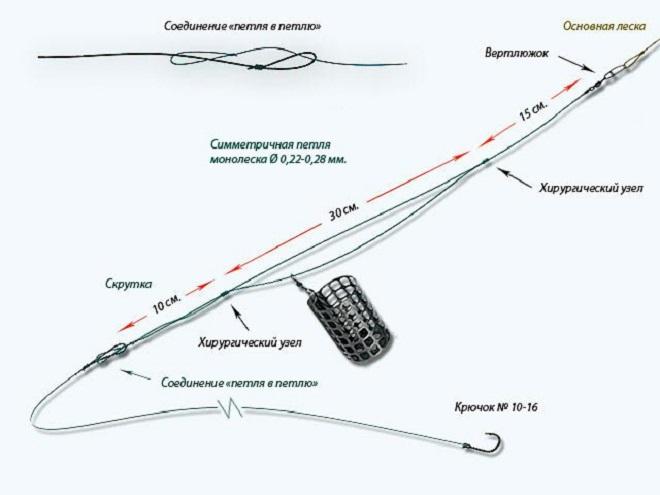
It is important to correctly perform the installation geometry - the difference in the arms, the length of the twist on the feeder, otherwise it will not work properly. The asymmetrical feeder loop is knitted from rigid feeder monofilament 0.25-0.3 mm or fluorocarbon of the same diameter. This setup is used for catching active river fish in the summer, with a good bite.
Online montages
In cold water, during periods of passivity of crucian carp, it is better to work with inline rigs, while when casting, do not tighten the quivertip, leaving more freedom to the equipment. The leashes are thin and long, the hooks and attachments are small. Everything is aimed at reducing the possibility of arousing at least some suspicion in the lazy and cautious silver. In still water, as with bream, after casting the rig, you can pull the bait towards you to the length of the leash. At the same time, the feeder is displaced from the feeding spot, and a hook with a nozzle is placed in its place.
- Installation of feeder gear for crucian carp is based on the running feeder principle - the fishing line is passed through the eye of the feeder, then a twist is tied with a loop on the leash. The length of the twist is slightly larger than the dimensions of the feeder, so that the leash does not overlap when casting. You can place a stopper on top of the base and use its position to regulate the free movement of the equipment, achieving self-notching. Running feeder
- Running with a branch is the same, only a branch with a bead or swivel is additionally attached to the feeder, through which the main fishing line is passed. This configuration of the running feeder is even more articulated, making it easier for the fish to pull out the line. The sliding unit is raised above the feeder - therefore this equipment option is even more preferable for cautious fish, especially on a soft bottom among vegetation (so that nothing prevents the crucian carp from freely pulling out the line when biting and not feeling any resistance).
You can properly equip a feeder for crucian carp using special inline feeders or familiar watermelons, springs with a sinker. The principle of operation is the same as in the donk - the feeder slides along the forest, passed through a through channel in the structure. This option is the same method in the sliding version of the rig. It’s convenient when it’s better to take it inline in current conditions on a sticky mess with a short leash and placing the bait near the groundbait.

This is the case when the classic feeder doesn’t take it, but the old men with clubs nearby pull the crucian carp onto the regular donkeys. A special method feeder costs 2-3 times more than a regular watermelon or spring. In the inline feeder version, there is no need to put any rocker arms, bends and other unnecessary things into such equipment. Just one leash with a hook and an attachment (a foam ball) is enough.
Components
The easiest way is to go to a fishing tackle store and buy the tackle already assembled, but it will not always be of high quality. A real fisherman knows that a do-it-yourself installation will be stronger and more reliable; if it fails, you will only have yourself to blame. Before starting work, you should carefully study the components, purchase everything you need, paying attention to the quality of the materials used. To work you will need:
| components | quantity |
| the basis | braided cord 0.5-0.8 m. |
| feeder | 1 PC. |
| leash material | braided cord, several pieces of 4-7 cm |
| hooks | depending on the number of leashes |
| sinker | from 20 g or more |
Victoria Leshchenko
I've been working hard in the fishing tackle department for the past six years. I can help you assemble almost any gear.
Ask a Question
Instead of stoppers, you can use beads. But you should choose a neutral color so as not to scare off a potential catch with an acidic color.
It is worth understanding that when collecting, you should first think about the number of feeders, the catchability and type of installation depend on this. The do-it-yourself crucian killer tackle for three or more feeders turns out to be blind, but with one the installation is sliding.
Advantages and disadvantages of gear
Donka is a bottom fishing rod, with the help of which crucian carp are fished out from the depths of a reservoir or away from the shore, where the fish are less wary and behave more actively. The tackle has not only a number of advantages, but also certain disadvantages that must be taken into account when choosing the appropriate option.
- Among the advantages of this gear, the following should be noted:
- Possibility of use in any reservoir and at different depths;
- it is convenient and effective even in noticeable wind, when the float rod is completely useless;
- catching fish is easier and faster;
- there is a greater chance of catching large prey, since the structure of the tackle itself reduces the number of losses during fishing;
- equipment and bait do not move under the influence of underwater currents;
- bait for luring can be located in close proximity to the hooks - in a feeder on the fishing line itself;
- it is possible to make a donk yourself in a short time and without special costs;
- you can install a bite alarm;
- The fishing process itself is possible in several ways, taking into account the weather and fishing location.
The main purpose of using this type of gear is to catch large-sized specimens, which for the most part go to depths quite far from the shore.
Did you know? The world-famous aquarium goldfish was bred by the Japanese from the common crucian carp.
- The disadvantages of this fishing method are:
- placement of gear on the ground is possible only if certain rules are observed, which limits the mobility of the fisherman;
- access to the bottom of a reservoir with dense vegetation and snags, to submerged objects, which are the favorite habitats of crucian carp, is difficult due to the high probability of gusts and tangled gear;
- early in the morning the fishing rod will not live up to expectations, because the fish leaves the depths in search of food.
Finding a fishing spot
But before we start collecting our feeder gear for crucian carp, we need to know where to look for it.
Spring crucian carp
The activity of crucian carp begins to manifest itself when the water heats up to 5-7 degrees, at this time it moves through the reservoir in search of food, it is worth remembering that crucian carp does not like the flow very much, especially in early spring and late autumn. Now, if the day is sunny, it can be found close to the shore, at a depth of 1.5 m, since at such a depth the water warms up faster. Promising places will be underwater hills abundantly covered with grass, snags, dense thickets of reeds, and meadows flooded during floods. On cold cloudy days, or in times of danger, the fish go deeper. In early spring, you should initially use two rods, throw one in shallow water, the second at a considerable distance from the shore and see where the crucian carp is most active, and catch there.

With gradual warming and the approach of spawning season, the fish move into quiet bays, abundantly covered with reeds. Spawning in southern latitudes is the beginning of May, in middle latitudes it is mid-to-late May, lasting 3-4 weeks.
Fishing for crucian carp on a feeder in summer
In summer, the best time for fishing for crucian carp begins at dawn and ends at 9-10 am; in the evening it can actively begin to be caught 2 or 3 hours before sunset. Night fishing for crucian carp can also be quite effective. But during the day, when the summer heat sets in, the feeder equipment for crucian carp may lie in vain. Often, in shallow, standing reservoirs during particularly hot days, crucian carp may not be caught at all during the entire day. Crucian carp are most active in the first month of summer, now at the beginning of fishing, use several rods, throwing them at different distances:
not far from the shore at the border of aquatic vegetation.
at a distance of 25-35 m, especially if there are islands of aquatic vegetation (throw at a distance of 1-2 meters from them).
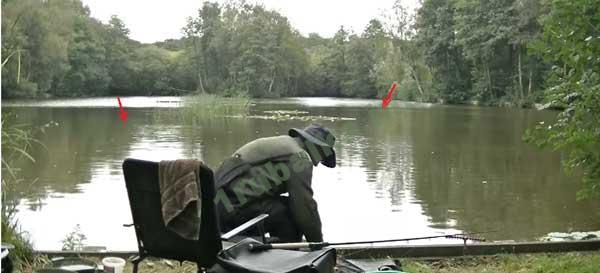
Then, having found the adhesive place, he will concentrate on this area. Crucian carp loves a soft muddy bottom covered with grass, algae (not hornwort), reeds or reeds, but you can also find crucian carp on a bottom covered with shellfish. Crucian carp especially loves places on the border of aquatic vegetation and clean water, so catching it is successful in algae windows, the main thing is that their density is not too high, and you can pull out the feeder without breaking the feeder equipment for catching crucian carp. In summer, crucian carp bite well in cloudy and windy weather. On rivers and reservoirs, you need to look for it on the lower edge, especially if there is a flat bottom, large individuals can be found in holes, it can also be found in quiet creeks, oxbow lakes and bays overgrown with reeds and algae.
Autumn
In September, there is a decline in the summer heat, and the activity of crucian carp increases significantly; this period lasts until the end of Indian summer. At this time, crucian carp can be active throughout the daylight hours, in addition, its biting in small reservoirs becomes more active, where during the August sunshine, it ignored our baits. With the onset of autumn cold weather and a gradual decrease in temperature, its activity also decreases; now the most favorable time for fishing will be when the weather is warm and sunny for several days. In October, you need to look for crucian carp near holes and riverbeds at a depth of 3-5 m, while leaving the fishing in ponds and bays and focusing on rivers and reservoirs. In November, on the eve of the winter cold, crucian carp stay in wintering pits and bite very rarely. Now, before preparing feeder gear for crucian carp, you need to ask avid fishermen on which bodies of water in the area it is still active.
For more information about the habits of crucian carp, read the article fishing for crucian carp and the gear necessary to catch a trophy
Types of catchable bottom gear
The age of bottom fishing rods is comparable to the age of float fishing rods - they have been known for hundreds of years. For a long period of time, these gears practically did not change their design, however, due to the development of the production of fishing attributes, their species diversity has increased noticeably.
The following options are available:
- classic donka;
- "pacifier" or plug;
- with rubber shock absorber;
- Donka with a feeder;
- traditional snack.
Each species has distinctive characteristics in its structure.
Important! Crucian carp is careful and reacts sensitively to “rough” equipment - if it suspects danger, it will instantly leave. That is why the thickness of the fishing line is important for all types of equipment.
Classic dong
A standard donkey is a monofilament line 0.25–0.3 mm thick, wound on a reel made from a piece of wooden plank. Instead of wood, you can use a regular inertial coil. The length of the fishing line does not exceed 40 m, since it is technically difficult to cast even 25–30 m. A sinker is attached to the end of the fishing line. Sometimes metal rivets are used for fastening, which makes it possible to replace loads. It is better to use the classic version of the tackle in clean and shallow waters, avoiding potential danger to the fishing line. For example, for a stationary body of water, a load weighing up to 50 g will be sufficient, but for fishing in strong currents, a weight of up to 200 g may be needed. On the main part of the fishing line, loops are made every 1.5–2 m (usually no more than 5 pieces), into which they are woven leashes made of thinner fishing line (up to 0.18 mm). You can limit yourself to one leash - it all depends on the activity of the fish and the experience of the fisherman. The intended fishing area must be fed in advance.
With a feeder
The most common option is the classic form, where the feeder replaces the load. A fairly heavy container is filled with complementary food, so the immediate catch area is constantly fed. To cast the specified equipment, use a bottom rod with a reel so that the throw is as far as possible.
Important! A feeder is a modern version of a bottom fishing rod with a feeder, which is a mesh container.
The simplest example of a donkey with a feeder is the makushatnik . A weight and “spiky” leashes are attached to the main cord. The sinker is complemented by a piece of cake. The same fishing line is quite suitable for this. You can also make a hole in the crown and pull the cord through. Hooks are inserted on the sides of the piece.
Making a “crucian carp killer” with your own hands
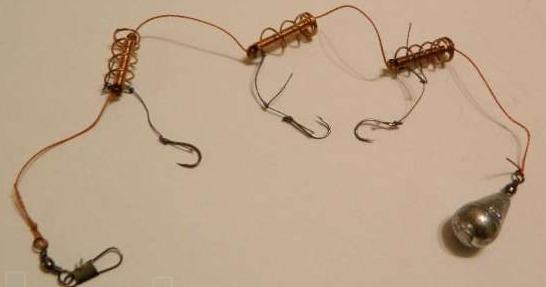
For successful fishing, you can change the design of the gear or make it yourself. Since the variety of crucian carp killer is not very different from the original, changing it does not take long. The classic tackle “crucian carp killer”, also known as “from Mikhalych”, is extremely simple to make. This is exactly what we will do.
The fishing line is chosen with a thickness of up to 0.4 mm, the sinker should be lead weighing 100 grams , as well as small hooks and several feeders. If you have sinkers, leashes and feeders, follow the following instructions:
- You need to tie a weight to the tip of the fishing line.
- Place a bead over the weight.
- Thread a fishing line through the feeder.
- The second bead must be placed so that the feeder has an outlet of several centimeters.
- Place the lower stopper on the other feeder.
- Do similar options for all the feeders that are available in the fishing tackle.
- Tie the leashes into loops and tighten them just above each feeder.
- Instead of a leash, you can use an elastic band.
Do not use beads that are too bright or of unnatural colors; they will only scare away the crucian carp. Do not make the leashes on which the hooks are attached too long. The maximum length is 6-8 centimeters, no more. Do not use double or treble hooks.
Selection of hooks
Hooks are used to catch fish and attach bait to them. The best option when using the “Crucian Carp Killer” is hooks size No. 4-6 . It will be difficult to attach, for example, bloodworms to a large hook size. Hooks with an extended shank are also used.
The hook consists of:
- Forend;
- Podeva;
- Abalone;
- Sting with a beard.
To choose the right hook, you need to know what kind of fish to hunt. But since we are talking about crucian carp, foreign companies such as: Partridge of Redditch (English company) Owner (Japanese company) Mustad (Norwegian company) are best suited;
How to choose a sinker
Depending on the location of the catch and the casting distance, you can select the necessary sinker. For shallow reservoirs, choose a sinker weighing 10 grams. If an angler goes fishing on a boat and is going to make long casts, then in this case a massive sinker weighing from 80 to 100 grams is suitable.
Feeders
One of the main roles in fishing for crucian carp is played by the feeder. A self-respecting fisherman always has several feeders of different shapes, because you can never say exactly what the fishing conditions will be.
- The shape of the feeder is chosen depending on the depth of the reservoir. If the water is stagnant, then the shape of the feeder is not so important, but where there is a current, a rectangular or triangular feeder will do.
- The amount of bait should correspond to the size of the feeder. If the angler does not want the fish to immediately become satisfied with food from the feeder while fishing, then smaller structures should be used. After all, when the crucian carp eats all the food, it will not want to play with the bait, and the crucian carp will swim away in search of new food.
- Weight depends on casting and river flow. 50 grams of food gets soaked in water and increases its weight.
What kind of bait can be put in the feeder?
- breadcrumbs;
- boiled peas;
- pearl barley or semolina;
- bread crumb;
- dung worms or maggots;
- It is best to add the strong smells of garlic, anise or mint to the food.
Standard version of the “crucian carp killer”
- To assemble the “crucian carp killer” you will need a monofilament line with a thickness of 0.3 to 0.4 mm or a braided cord with a slightly smaller cross-section and a length of 80-100 cm. Fluorocarbon fishing line is also a good option. Some even use a nylon cord. However, it makes the equipment too noticeable, although it is more durable.
- We attach a reliable carabiner fastener to one end of the fishing line or cord to attach the load, and also, if necessary, quickly change it to a lighter or heavier option.
- After that, spring feeders are inserted onto the fishing line through a special tube built inside each one. Now you need to fix them at a distance of 10-15 cm from each other. You can completely limit their movement with stoppers by installing them end-to-end on both sides. If you want to make the tackle more sensitive, then place the stoppers at a short distance (2-3 cm) from each feeder.
- The next step is to install the leashes. Their length is approximately 5 cm. If they are larger, they may get confused with other elements of the equipment. The leashes must be tied directly to the feeder (by some coil of the spring).
- All that remains is to install a swivel with a clasp on the other end of the fishing line.
With this DIY installation option, you don’t have to use a weight at the end of the fishing line. It is enough to install feeders with internal loading. They are easy to find in any fishing store.
The outermost feeder should be heavier than the others. Otherwise, the equipment will constantly get tangled when casting and immersing in water.
Technology for making a do-it-yourself feeder for catching crucian carp
You need to start working by winding the wire around the device. It is better to hold the end of the wire with pliers, pressing the wire against the device. The number of turns depends on the size of the feeder being made. Usually 7-12 turns are enough.
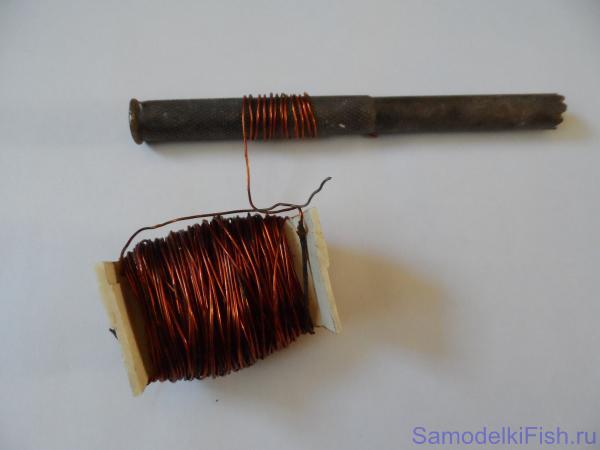
When the spring reaches the desired size, cut off the wire and proceed to the next stage. This is the giving of a barrel shape to a wire structure.
It is not difficult to give this look to the feeder. It is necessary to increase the central coils, and moving to the edges of the spring, gradually reduce the diameter of each coil.
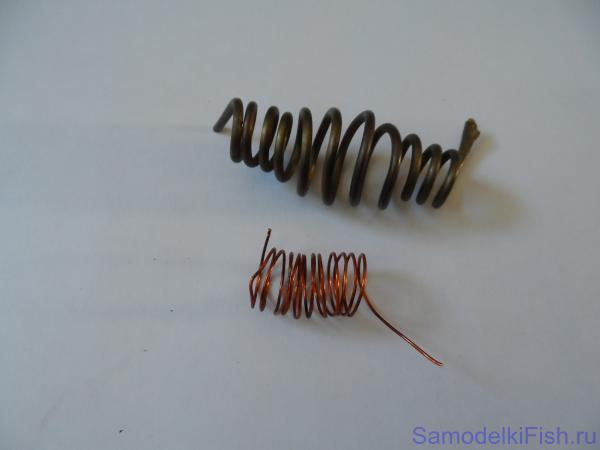
It is more convenient to carry out the work using round nose pliers. Excess wire is removed from the edges with wire cutters. Now you need to insert a tube into the spring so that the fishing line can move freely when a fish bites. To do this, a plastic rod or metal tube is inserted inside the spring.
The outer coils of the spring are used to crimp the tube. If a metal tube is used, it is better to insert a piece of electrical wire insulation inside it.

This will prevent the line from breaking. Excess tube is cut off with a knife or bitten off with pliers. The result is a nice looking feeder that will deliver food to the fishing point.
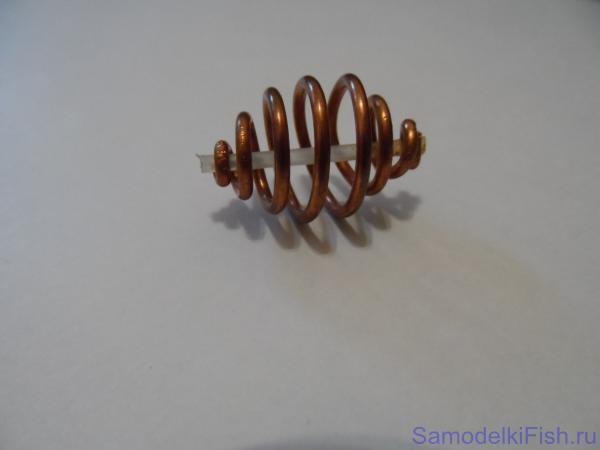
Equipping a spring feeder for catching crucian carp
The spring is equipped in a sliding or “blind” design.
In the case of fixed equipment, the main line is tied to the first turn of the feeder. Leashes with hooks (2-3 pcs.) are attached to the main fishing line in increments of 15-30 cm or mounted to the coils of the spring (if the wire is thick).
If sliding equipment is made, then the main fishing line is passed through the tube of the feeder - the spring. Then you need to install a rubber stopper or a lead sinker. All that remains is to make a knot loop at the end of the main line. Similar loops are knitted above the spring at a distance of 20-30 cm. Leashes with hooks will be mounted to the loops for fishing.
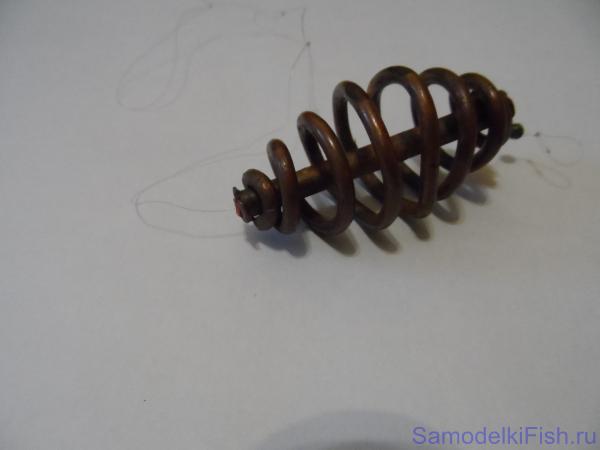
Tactics for catching crucian carp using a spring feeder
When using a spring for catching crucian carp, both loose and viscous bait is suitable. The feeder is filled with it and several casts are made for the starting feeding. Leashes with hooks are not attached. When feeding is done, you can install a smaller spring with leads.
The bait is compacted in the feeder so that it is washed out no faster than 10 minutes. All that remains is to attach the bait to the hooks and throw the equipment into the feeding area.
The fishing rod is placed on a stand, the fishing line is tensioned, and a bite alarm is mounted. The friction brake is weakened, and if there is a baitrunner, it should be turned on. Now you can sit comfortably and wait for the fish to bite.
To catch crucian carp at shallow depths and short distances, it is better to use small springs made of thin wire 1-2 mm. If you need long casting with a large depth at the fishing point, then it is better to install large models made of 2.5-3.5 mm wire. Having a wide range of feeders, the angler can easily select the optimal spring for fishing in a particular fishing area.
Other variations of the crucian carp killer tackle
- Killer of crucian carp with a blind rig . In appearance, this version of the tackle is somewhat reminiscent of a garland . All three feeders on the fishing line are securely fixed using locking beads. In order to avoid tangling of the tackle when casting, an additional weight , which should have a greater mass than the feeders filled with bait. When casting, it will tighten the line and prevent the feeders from getting tangled with each other. The length of the leashes is recommended to be about 4 cm .
- Crucian carp killer with a floating rig . In this version of the gear, not three, but one feeder . It will also serve as a load . Sliding along the fishing line is limited by stop beads . At the end of the rig, leashes , which, to avoid tangling, can be equipped with a so-called “yoke” - small antennae made of thin wire.
